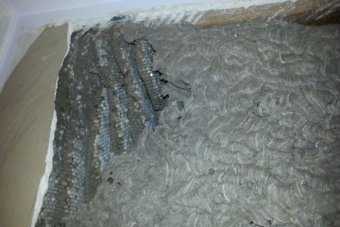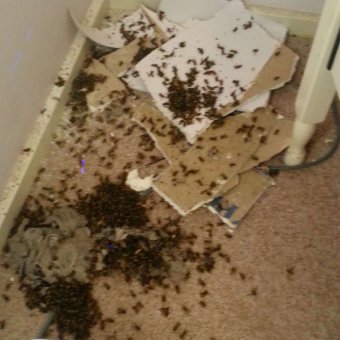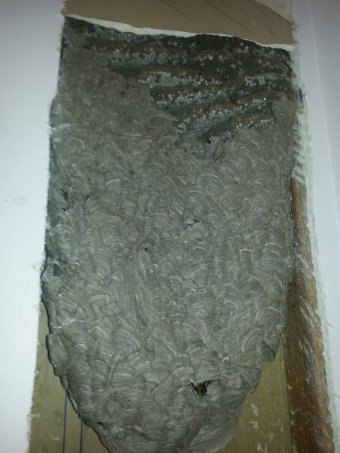Autumn ‘dangerous season’ for European Wasp attacks, expert says
March 8, 2017
Adrienne Francis

PHOTO: The ACT Government’s wasp hotline has been running hot. (ABC Rural: Clint Jasper)
Last year’s wet winter weather conditions prompted significant number of European wasps to seek shelter inside Canberra houses and apartments – and the full impact is only just being felt, according to an ACT expert.
Since August the ACT Government’s eWasp Hotline has recorded 66 nests in the ACT, with 40 located within wall cavities and the reminder in the environment.
And hotline operator and environmental consultant Jim Bariesheff said many nests go un-reported.
“With the wet winter, it has drowned and killed off a lot of queens that would have made their nest in the ground, “Mr Bariesheff said.

CoreEnviro Solutions senior pest and weed officer Jim Bariesheff inspects a European wasp nest in Evatt. Photo: Jay Cronan
“So we are seeing less nests around creeks, ponds and along the river corridors.”
Autumn marks a dangerous season for European wasp attacks, according to Mr Bariesheff.
“This is the time of the year where the nests have outgrown the wall cavities and they start chewing through gyprock and coming into people’s homes” he said.
“People are more concerned and fearful about it than ever”.
“Wasp invasion ‘alarming and distressing”
Palmerston resident Joe Van Akker is one of the 40 ACT residents to have discovered a nest in a wall cavity.
She said her family was very fortunate to have avoided being stung.

PHOTO: A pile of wasps on the floor after being exterminated. (Supplied: Jim Bariesheff)
“They had eaten through at the cornice and that’s how they got in.”
“It was a pencil sized hole that they had got through (initially to access the wall cavity).”
“When we touched it, the whole wall started crumbling and that’s when my panic took over.”
“It became larger than a tennis ball-sized hole.”
A pest controller located the nest full of larvae in Ms Van Akkers garage wall, cornice and ceiling last week.
“We heard scratching, but we suspected birds,” she said.
Then we came home from work and school through the entrance way from our garage and there were 40 insects, which I through were bees.
“They were swarming around at head height and even down to chest height, like it was just above my kids’ heard, and they are primary school age”.
Don’t spray them yourself: expert says
After spraying the insects with insecticide, Ms Van Akker identified them as European wasps. But Mr Bariesheff warned residents not to use insecticides.
“When you spray insecticide, you are actually aggravating the nest, you are making them more aggressive and more dangerous,” he said.
“Then the nest is on alert and most of the time the chemical does not get the nest.
“You have to kill the queen and destroy the nest to eradicate them out of your wall.”
He urged affected resident to engage qualified pest controllers, saying the insects were extremely adaptable and clever.
“They will find a way into a bee suit, and that’s why we say to people, please don’t treat them, because some people put on a veil and go off and treat them, but they will find a way through,’ he said. Mr Bariesheff also warned Canberrans not to black cracks, crevices, eaves or doors that may allow the insects access to wall cavities.”

PHOTO: A wasp nest in a wall cavity in Mawson. (Supplied: Jim Bariesheff
“That’s when they will also start chewing through your gyprock because they want to get out.”
Mr Bariesheff was hospitalised after being stung 13 times, including once on the forehead, while treating a European wasp nest at an Ainslie property a year ago.
“If you do get stung, especially on the nest or head, you need to seek medical attention straight away,” he said. “Antihistamine always helps, and so does a cold compress”.


